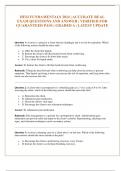Exam (elaborations)
HESI FUNDAMENTALS 2024 | ACCURATE REAL EXAM QUESTIONS AND ANSWER | VERIFIED FOR GUARANTEED PASS | GRADED A | LATEST UPDATE
- Course
- Institution
HESI FUNDAMENTALS 2024 | ACCURATE REAL EXAM QUESTIONS AND ANSWER | VERIFIED FOR GUARANTEED PASS | GRADED A | LATEST UPDATE
[Show more]



